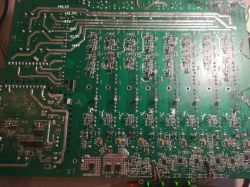kudlatyy1 wrote:If you were He came maybe he wouldn't start smoking?good that on time I have traveled the regulator began to smoke

Czy wolisz polską wersję strony elektroda?
Nie, dziękuję Przekieruj mnie tam
INtRO_Tech wrote:
A request for one more measurement - auxiliary voltages, if you could measure it, it would be great, I mean the +/- voltage on the conduits on the SMD bridge.
Krzychu1843 wrote:According to the documentation, it's true - there should be 2V more than the output, but it works - it gives the output what it gets at the input. Operational amplifiers do not have any problems when operating with a slightly low voltage, so there is no point in trying to mess around.
INtRO_Tech wrote:one thing makes me wonder - the inverter for two IGBTs probably does not give full voltage to the transformer,
Krzychu1843 wrote:It is not working and we are all aware of it, but the results of this work are sufficient to fix the sewers
Krzychu1843 wrote:As for the oscillations - yes, but if it were of great importance, the problem would appear on 4 channels, not only on 2. The most important thing is that the power supply should be symmetrical - the opamps will not be fussy - at least in my case.
Krzyk2 wrote:Well, the problem with this amplifier is that there are 6 versions of the discs, and thus each of the writers is right, but not entirely
Krzyk2 wrote:There are no gp40066d transistors while there are IRGP4066D and former AUIRGP4066D1 (still available from some distributors). And what is this nonsense you write about the weaker versions of the IRGP4066D, what is it? Is there any manufacturer's note, or is it just your guess?where the gp4066d transistors were almost 100w weaker, only in newer ones they were corrected,
Krzyk2 wrote:the rest of the transistor is important, i.e. IRGP4066D-EPBF
Krzyk2 wrote:Nothing when it comes to durability, I agree with you that it is short, but what to expect in an oven that is not adapted to continuous operation to drive bass

Krzyk2 wrote:This year I had the opportunity to make over 20 pieces of thomann phrases and unfortunately most of them were in version the oldest, i.e. and b or c where the transistors gp4066d was almost 100w weaker only in the newer versions they were corrected for correct versions, unfortunately in Poland in shops it is a lottery because they are sold as correct and in practice the old type.
The correct information is only provided on the collective packaging .
Even at TME it turned out that they had weaker ones and they shot.
kudlatyy1 wrote:That's why I gave up on the repair, I will use the housing and blocks to make another four-channel amplifier
aaanteka wrote:However, civil liability remains in the case of the use of this non-certified sound equipment where third parties are involved. You can not badly develop the status of a criminal with such modernizations.
